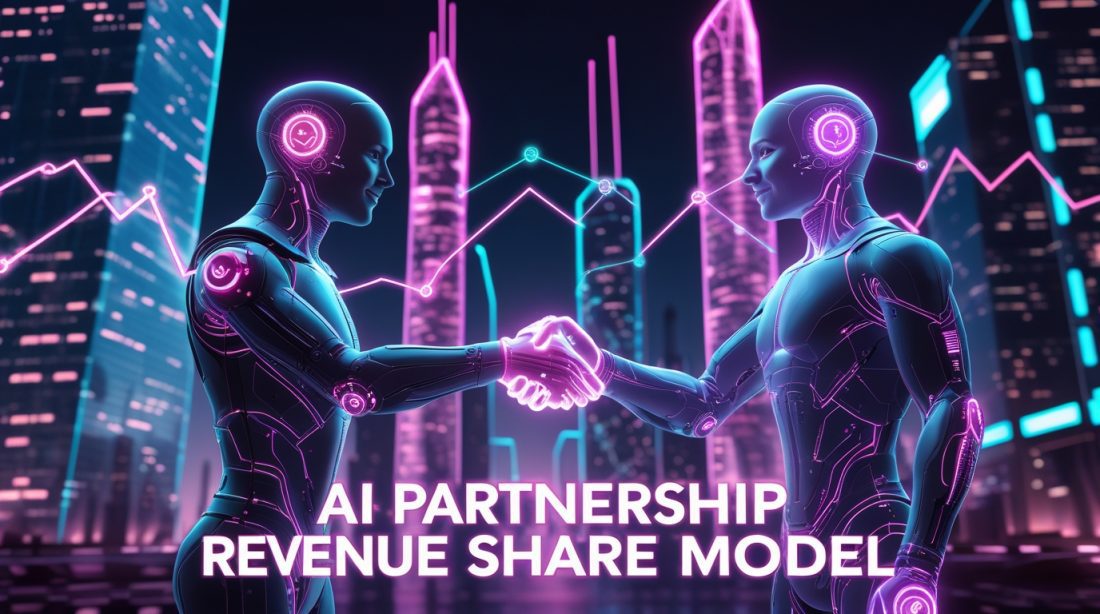For years, the relationship between AI vendors and their enterprise clients has been straightforward: you buy a license, you implement the software. The results, however, have been staggeringly one-sided. A recent MIT report revealed a shocking truth: despite billions in investment, 95% of enterprises are seeing zero return on their AI investments. The old “buy and build” model is broken.
In its place, a more collaborative, aligned, and powerful model is taking root: the AI partnership revenue share model. This isn’t just a new pricing strategy; it’s a fundamental shift to “AI-as-a-Partner,” where vendors and enterprises co-create tools, share risks, and—crucially—split the rewards. This performance-based partnership is rapidly becoming the dominant strategy for companies seeking real, measurable value from AI.
Why the Old AI “Buy and Build” Model is Failing
The traditional approach to enterprise AI is hitting a wall. The chasm between pilot projects and production-scale success is vast. While 78% of organizations report using AI, the journey from exploration to transformation is riddled with failure. The MIT analysis found that while 60% of organizations evaluate custom AI solutions, a mere 5% successfully reach production deployment with sustained business value.
The core problem is a misalignment of incentives. Vendors sell software licenses; their goal is deployment. But enterprises need business outcomes—increased revenue, reduced costs, and quantifiable efficiency gains. When a pre-packaged AI tool fails to adapt to a company’s unique workflow or fails to deliver a clear ROI, it becomes expensive “shelfware.” This model leaves enterprises bearing all the risk, while vendors walk away after the sale is complete.
5 Reasons the AI Partnership Revenue Share Model is Succeeding
1. Why Does a Shared Risk Model Lead to Higher Success Rates?
The answer is radical alignment. In a revenue share model, the vendor only wins if the client wins. This transforms the vendor’s role from a passive tool provider to an active invested partner.
The data supports this powerfully. According to the same MIT study, organizations pursuing strategic external partnerships achieve a 66% deployment success rate, compared to a dismal 33% for internally developed tools. This 2x success rate isn’t a coincidence. It’s the direct result of a partnership structure where both parties are financially motivated to ensure the AI solution is continuously optimized, properly integrated, and driving tangible business results. The vendor is incentivized to provide ongoing support, model fine-tuning, and strategic guidance—their revenue depends on it.
“Organizations pursuing strategic external partnerships achieve a 66% deployment success rate, compared to a dismal 33% for internally developed tools.” – MIT Report on AI Investment
2. Why Are Co-Branded Tools a Smart Go-to-Market Strategy?
The answer is built-in trust and accelerated market entry. For the AI vendor, a partnership with an established industrial brand provides instant credibility and access to a pre-qualified customer base. For the enterprise, co-branding a tool signifies a deep collaboration and a stamp of approval, turning them from a passive consumer into an innovator in their sector.
This strategy is a direct response to market concentration in the AI space. General AI assistants capture 81% of today’s $12 billion consumer AI spend. For a specialized AI vendor, partnering with an industrial leader allows them to bypass the intense competition and embed their technology directly into industry-specific workflows. The enterprise partner benefits by offering a cutting-edge, AI-augmented service to their clients under their trusted brand, creating a new revenue stream without having to build the tech from scratch.
3. Why Does This Model Unlock Higher ROI for Both Parties?
The answer is a direct link to value creation. Traditional SaaS subscriptions are a cost center, with often murky and unpredictable ROI. The AI partnership revenue share model flips this script by tying costs directly to generated value.
This aligns with a broader industry shift toward consumption-based and value-based pricing. As McKinsey notes, “As AI capabilities scale, software incumbents will likely need to incorporate some form of consumption-based pricing,” as it creates a “land and expand” organic growth motion that is “fairer” to customers. In a revenue share, the enterprise’s costs are directly proportional to the new revenue the AI tool helps generate. This makes the investment predictable, justifiable, and inherently profitable. It forces a focus on high-impact use cases where the value is clear and measurable, moving beyond “productivity theater” to genuine financial impact.
4. Why is This Approach Perfect for Industrial AI Applications?
The answer is domain specificity. Generic AI models often fail to capture the nuanced complexities of industrial settings—supply chain logistics, manufacturing quality control, or specialized equipment servicing. The co-creation process inherent in a deep partnership ensures the final tool is precisely tailored to these unique challenges.
McKinsey’s analysis of the CPG industry highlights this, showing that the greatest value from AI is concentrated in specific value streams like customer and channel management and consumer insights. An AI model co-developed by a vendor and a CPG giant, for instance, can be fine-tuned on proprietary data to optimize retail trade promotions, which can account for 20% of a company’s revenue. This level of customization, funded and validated by a shared revenue stream, is something off-the-shelf software cannot replicate.
5. Why Are These Partnerships the Future of AI Scaling?
The answer is that they combine agility with scale. Even the most resource-rich enterprises struggle to keep pace with the breakneck speed of AI innovation. The AI industry is projected to grow at a staggering CAGR of 31.5%. Partnering with a specialized vendor allows large companies to leverage external R&D and agility while providing the vendor with the scale and industry data they need to refine their product.
This creates a powerful flywheel: the enterprise gets a continuously improving, state-of-the-art tool without massive internal R&D overhead, and the vendor gets a live, real-world environment to train and enhance its models. This symbiotic relationship is crucial for scaling AI beyond isolated pilots into core business operations, finally bridging the gap between AI’s promise and its delivery.
The Bottom Line: A Partnership Built for Performance
The move toward the AI partnership revenue share model is a market correction. It’s a direct response to the high costs and high failure rates of the past decade. By aligning vendor success with client outcomes, fostering co-creation, and directly linking cost to value, this model is proving to be the most reliable vehicle for achieving genuine, scalable AI transformation.
For industrial leaders in 2025, the question is no longer whether to invest in AI, but how. The evidence is clear: the most promising path forward is not to go it alone, but to find a partner whose success is irrevocably tied to your own.
FAQ
What is an AI partnership revenue share model?
It’s a business arrangement where an AI vendor and an enterprise client co-develop or deeply integrate an AI tool. Instead of a simple software license fee, the vendor’s compensation is a percentage of the new revenue or cost savings the tool directly generates for the enterprise.
What are the main benefits for the enterprise?
Enterprises benefit from reduced upfront risk, access to specialized AI expertise, a solution tailored to their specific needs, and a direct, transparent link between AI investment and ROI. This model drastically increases the chance of successful deployment and scaling.
How does this differ from traditional SaaS pricing?
Traditional SaaS typically charges a per-user or flat subscription fee, a cost incurred regardless of the tool’s business impact. The revenue share model is performance-based; costs scale with success, ensuring the vendor is fully invested in delivering continuous value.
Which industries are best suited for this model?
This model is particularly effective in complex, data-rich industrial and B2B sectors like manufacturing, CPG, logistics, financial services, and healthcare, where domain-specific knowledge is critical and the value of AI can be directly measured in operational efficiency or new revenue.
Fast Facts
The traditional “buy a license” model for enterprise AI is failing, with 95% of projects delivering zero return. The solution is the AI partnership revenue share model, where vendors and companies act as true partners. They co-create tools and share the revenue generated, leading to a 2x higher deployment success rate because both parties are aligned on achieving real business results.
Stay Ahead of the Curve on Industrial AI
The landscape of AI partnerships is evolving fast. Get the latest analysis, case studies, and insights on how top companies are leveraging these models for growth delivered directly to your inbox.
[Subscribe to our Industrial AI Analysis Newsletter]



